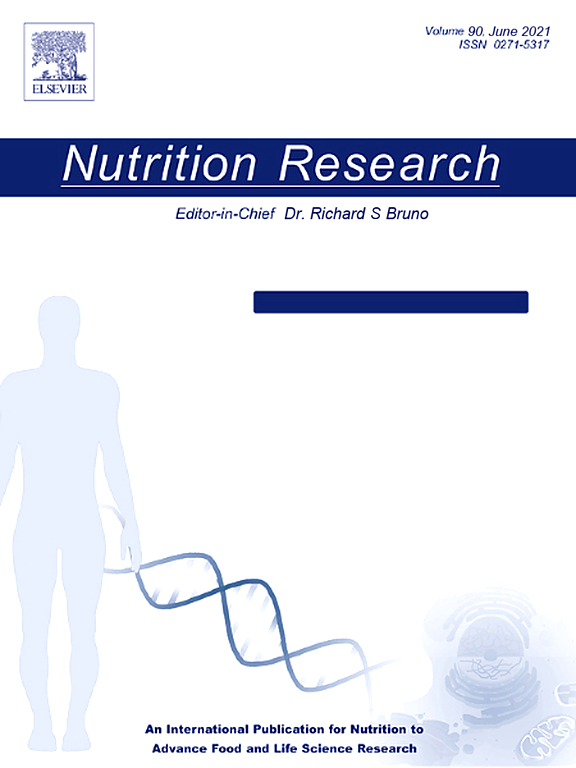高脂饮食和低剂量链脲佐菌素 2 型糖尿病模型可诱导雄性 C57BL/6J 小鼠产生高胰岛素血症和胰岛素抵抗,但不会诱导雌性 C57BL/6J 小鼠产生高胰岛素血症和胰岛素抵抗。
IF 3.4
3区 医学
Q2 NUTRITION & DIETETICS
引用次数: 0
摘要
由于动物研究主要使用雄性啮齿类动物,因此将饮食干预代谢疾病疗效的临床前研究结果转化为人类临床研究具有挑战性。我们的目的是评估高脂(HF)饮食和低剂量链脲佐菌素(STZ)联合模型在雄性和雌性 C57BL/6J 小鼠中诱导 2 型糖尿病(T2D)的效果。我们假设不同性别小鼠的 T2D 生物标志物会有显著差异。我们给小鼠喂食低脂(LF)饮食(10% 千卡热量来自脂肪)或高脂饮食(60% 千卡热量来自脂肪)+ STZ 注射(30 毫克/千克/天,连续 3 天)。与LF相比,HF+STZ处理的雌雄小鼠体重都有所增加,并出现餐后口服葡萄糖耐量受损。只有雄性小鼠在接受HF+STZ治疗后出现空腹高血糖、空腹高胰岛素血症和胰岛素抵抗,这表明不同性别小鼠餐后高血糖的根本原因不同。对体重、血糖和胰岛素浓度等指标的主成分分析表明,只有接受高频+STZ治疗的男性出现了代谢紊乱,而低频组男性和两组女性的代谢紊乱情况明显重叠。根据我们的数据,我们同意我们的假设,即高脂饮食和低剂量 STZ 联合治疗 T2D 表型模型对小鼠的影响因性别而有显著差异。高脂饮食+低剂量 STZ 模型对研究雌性小鼠的胰岛素抵抗没有帮助。需要其他模型来模拟雌性 T2D,并研究饮食干预对该疾病的影响。性别二形性仍然是临床前和临床研究的一个重大挑战。本文章由计算机程序翻译,如有差异,请以英文原文为准。

The high-fat diet and low-dose streptozotocin type-2 diabetes model induces hyperinsulinemia and insulin resistance in male but not female C57BL/6J mice
Translation of preclinical findings on the efficacy of dietary interventions for metabolic disease to human clinical studies is challenging due to the predominant use of male rodents in animal research. Our objective was to evaluate a combined high-fat (HF) diet and low-dose streptozotocin (STZ) model for induction of type-2 diabetes (T2D) in male and female C57BL/6J mice. We hypothesized that T2D biomarkers would differ significantly between sexes. Mice were administered either a low-fat (LF) diet (10% kcal from fat), or HF diet (60% kcal from fat) + STZ injections (30 mg/kg/d for 3 days). Both sexes gained weight and developed impaired postprandial oral glucose tolerance on the HF+STZ treatment compared to LF. Only male mice on HF + STZ developed fasting hyperglycemia, fasting hyperinsulinemia and insulin resistance, suggesting that the underlying causes of postprandial hyperglycemia differed between sexes. Principal component analysis of measures such as body weights, glucose and insulin concentrations indicated metabolic derangement for males only on HF+STZ treatment, while LF group males and both groups of females significantly overlapped. Based on our data, we accept our hypothesis that the combined high-fat diet and low-dose STZ model for T2D phenotypes differs significantly in its effect on mice based on sex. The HF diet + low-dose STZ model is not useful for studying insulin resistance in females. Other models are needed to model T2D, and study the effects of dietary interventions in this disease, in females. Sexual dimorphism remains a significant challenge for both preclinical and clinical research.
求助全文
通过发布文献求助,成功后即可免费获取论文全文。
去求助
来源期刊

Nutrition Research
医学-营养学
CiteScore
7.60
自引率
2.20%
发文量
107
审稿时长
58 days
期刊介绍:
Nutrition Research publishes original research articles, communications, and reviews on basic and applied nutrition. The mission of Nutrition Research is to serve as the journal for global communication of nutrition and life sciences research on diet and health. The field of nutrition sciences includes, but is not limited to, the study of nutrients during growth, reproduction, aging, health, and disease.
Articles covering basic and applied research on all aspects of nutrition sciences are encouraged, including: nutritional biochemistry and metabolism; metabolomics, nutrient gene interactions; nutrient requirements for health; nutrition and disease; digestion and absorption; nutritional anthropology; epidemiology; the influence of socioeconomic and cultural factors on nutrition of the individual and the community; the impact of nutrient intake on disease response and behavior; the consequences of nutritional deficiency on growth and development, endocrine and nervous systems, and immunity; nutrition and gut microbiota; food intolerance and allergy; nutrient drug interactions; nutrition and aging; nutrition and cancer; obesity; diabetes; and intervention programs.
 求助内容:
求助内容: 应助结果提醒方式:
应助结果提醒方式:


